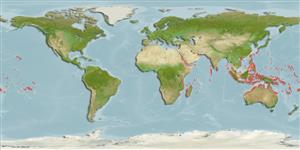Issue
Genus Williams, pers. comm.
Environment: milieu / climate zone / depth range / distribution range
Ekologi
laut berasosiasi dengan karang; kisaran kedalaman 0 - 3 m (Ref. 30874). Tropical; 30°N - 30°S
Indo-Pacific: Red Sea south to Durban, South Africa, east to the Marquesas and Tuamoto Islands, north to the Ryukyu Islands; throughout Micronesia.
Size / Weight / umur
Maturity: Lm ? range ? - ? cm
Max length : 15.0 cm SL jantan/; (Ref. 9710)
deskripsi pendek
Kunci identifiaksi (pengenalan) | Morfologi | Morfometrik
Duri punggung (Keseluruhan (total)) : 12 - 14; duri punggung lunak (Keseluruhan (total)) : 18 - 21; Duri dubur: 2; Sirip dubur lunak: 19 - 21; vertebrata, bertulang belakang: 25 - 27. Diagnosis: Dorsal fin XIII, 18-21, notched between spinous and segmented-ray portions; anal fin II, 19-21; pectoral rays 13-15 (usually 14); pelvic fin I, 3; caudal fin, procurrent rays 7, segmented rays 13. Vertebrae 12 + 25-27. Orbital cirrus simple and slender, may have a short lateral branch, less often up to 4 branches; nasal cirri short and palmate, may rarely have more than 6 branches; nuchal cirri simple and slender, may have a single branch or a ragged edge. Mandibular pores 6. Dorsal lips margin entire, ventral margin crenulated. Occipital crest absent, but large males have a low thin ridge (less than 1.8 mm); no crest or ridge in females Three color-pattern types described for different localities (see Ref. 9962). Body of males with 6-7 dusky bands with 1 or a pair of dark margined, pale, oblong spots on each band; dark spots on spinous dorsal, dusky lines on rayed dorsal. Females with spots on caudal peduncle; body sometimes with fine dark specks (Ref. 4404). Body depth at anal-fin origin 4.6-5.3 in SL (Ref. 90102).
Adults inhabit exposed outer intertidal reef flats, where it can hide in cracks and holes. Commonly observed clinging to rocks as the water recedes below them during the low cycle of the swell and this species is often confused with mudskipper gobies (Ref. 48636). They feed on filamentous algae and associated small invertebrates, such as foraminiferans, ostracods, copepods, and gastropods. Oviparous. Eggs are demersal and adhesive (Ref. 205), and are attached to the substrate via a filamentous, adhesive pad or pedestal (Ref. 94114). Larvae are planktonic, often found in shallow, coastal waters (Ref. 94114). Rarely used for aquarium fish.
Distinct pairing (Ref. 205).
Springer, V.G. and J.T. Williams, 1994. The Indo-West Pacific blenniid fish genus Istiblennius reappraised: a revision of Istiblennius, Blenniella, and Paralticus, new genus. Smithson. Contrib. Zool. 565:1-193. (Ref. 9962)
Status IUCN Red List (Ref. 130435: Version 2024-1)
ancaman kepada manusia
Harmless
penggunaan manusia
Perikanan: tidak ada kepentingan
Alat, peralatan
laporan khas
muat turun XML
Sumber internet
Estimates based on models
Preferred temperature (Ref.
123201): 25 - 29.3, mean 28.4 °C (based on 2554 cells).
Phylogenetic diversity index (Ref.
82804): PD
50 = 0.5020 [Uniqueness, from 0.5 = low to 2.0 = high].
Bayesian length-weight: a=0.00389 (0.00180 - 0.00842), b=3.12 (2.94 - 3.30), in cm total length, based on all LWR estimates for this body shape (Ref.
93245).
Trophic level (Ref.
69278): 3.3 ±0.43 se; based on food items.
Daya lenting (Ref.
120179): sedang, Waktu penggandaan populasi minimum 1.4 - 4.4 tahun (Preliminary K or Fecundity.).
Fishing Vulnerability (Ref.
59153): Low vulnerability (10 of 100).
Nutrients (Ref.
124155): Calcium = 115 [56, 183] mg/100g; Iron = 0.664 [0.377, 1.120] mg/100g; Protein = 18.5 [17.3, 19.6] %; Omega3 = 0.0767 [, ] g/100g; Selenium = 16.1 [7.5, 34.7] μg/100g; VitaminA = 144 [44, 446] μg/100g; Zinc = 1.83 [1.21, 2.64] mg/100g (wet weight);
